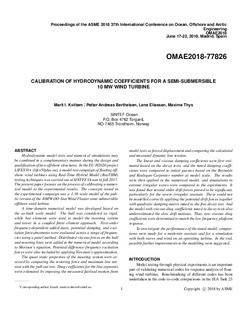| dc.contributor.author | Kvittem, Marit Irene | |
| dc.contributor.author | Berthelsen, Petter Andreas | |
| dc.contributor.author | Eliassen, Lene | |
| dc.contributor.author | Thys, Maxime | |
| dc.date.accessioned | 2019-01-08T17:16:16Z | |
| dc.date.available | 2019-01-08T17:16:16Z | |
| dc.date.created | 2018-09-26T13:21:07Z | |
| dc.date.issued | 2018-06-22 | |
| dc.identifier.citation | ASME digital collection, Volume 10: Ocean Renewable Energy | nb_NO |
| dc.identifier.isbn | 978-0-7918-5131-9 | |
| dc.identifier.uri | http://hdl.handle.net/11250/2579800 | |
| dc.description.abstract | Hydrodynamic model tests and numerical simulations may be combined in a complementary manner during the design and qualification of new offshore structures. In the EU H2020 project LIFES50+ (lifes50plus.eu), a model test campaign of floating offshore wind turbines using Real-Time Hybrid Model (ReaTHM) testing techniques was carried out at SINTEF Ocean in fall 2017. The present paper focuses on the process of calibrating a numerical model to the experimental results. The concepts tested in the experimental campaign was a 1:36 scale model of the public version of the 10MW OO-Star Wind Floater semi-submersible offshore wind turbine. A time-domain numerical model was developed based on the as-built scale model. The hull was considered as rigid, while bar elements were used to model the mooring system and tower in a coupled finite element approach. First-order frequency-dependent added mass, potential damping, and excitation forces/moments were evaluated across a range of frequencies using a panel method. Distributed viscous forces on the hull and mooring lines were added to the numerical model according to Morison’s equation. Potential difference-frequency excitation forces were also included by applying Newman’s approximation. The quasi static properties of the mooring system were assessed by comparing the restoring force and maximum line tension with the pull-out test. Drag coefficients for the line segments were estimated by imposing the measured fairlead motion from model tests as forced displacement and comparing the calculated and measured dynamic line tension. The linear and viscous damping coefficients were first estimated based on the decay tests, and the tuned damping coefficients were compared to initial guesses based on the Reynolds and Keulegan-Carpenter number at model scale. The results were then applied in the numerical model, and simulations in extreme irregular waves were compared to the experiments. It was found that second order drift forces proved to be significant, particularly for the severe irregular seastate. These could not be modelled correctly applying the potential drift forces together with quadratic damping matrix tuned to the free decay test. And the model with viscous drag coefficients tuned to decay tests also underestimated the slow drift motions. Thus, new viscous drag coefficients were determined to match the low frequency platform response. To inverstigate the performance of the tuned model, comparisons were made for a moderate seastate and for a simulation with both waves and wind on an operating turbine. In the end, possible further improvements to the modelling were suggested. | nb_NO |
| dc.language.iso | eng | nb_NO |
| dc.publisher | ASME | nb_NO |
| dc.relation.ispartof | ASME 2018 37th International Conference on Ocean, Offshore and Arctic Engineering - Volume 10: Ocean Renewable Energy | |
| dc.relation.ispartofseries | ASME 2018 37th International Conference on Ocean, Offshore and Arctic Engineering, Volume 10: Ocean Renewable Energy;OMAE2018-77826 | |
| dc.rights | Attribution-NonCommercial-NoDerivatives 4.0 Internasjonal | * |
| dc.rights.uri | http://creativecommons.org/licenses/by-nc-nd/4.0/deed.no | * |
| dc.subject | Semi-submersible offshore structures | nb_NO |
| dc.subject | Calibration | nb_NO |
| dc.subject | Wind turbines | nb_NO |
| dc.title | Calibration of Hydrodynamic Coefficients for a Semi-Submersible 10 MW Wind Turbine | nb_NO |
| dc.type | Chapter | nb_NO |
| dc.description.version | acceptedVersion | nb_NO |
| dc.rights.holder | Copyright © 2018 by ASME - accepted manuscript © the authors 2018 | nb_NO |
| dc.identifier.doi | 10.1115/OMAE2018-77826 | |
| dc.identifier.cristin | 1614011 | |
| cristin.unitcode | 7566,7,0,0 | |
| cristin.unitcode | 7566,9,0,0 | |
| cristin.unitname | Energi og transport | |
| cristin.unitname | Skip og havkonstruksjoner | |
| cristin.ispublished | true | |
| cristin.fulltext | postprint | |
| cristin.qualitycode | 1 | |

